TSGNY: Which textile techniques do you incorporate in your work?
Mary Zicafoose: I am a rug-weaver-turned-tapestry-weaver who developed a fascination with ikat about 25 years ago. What began pretty innocently with a few scraps of a Hefty garbage bag knotted around a hank of yarn has evolved into complex tapestry imagery created by very intricate and layered ikat wrapping and tying techniques. The process now demands months of wrapping, tying small pieces of japanese ikat tape — a brittle cellophane tape — around individual strands of mountains of silk and wool.

Wrapping ikat before dyeing. The weft section shown here will become approximately 3 inches of the finished piece.
MZ: For the last 10 years I have produced ikat tapestries almost exclusively. I’m currently working on a commission for a home that will require about 80,000 ikat ties. When done tying I will dye the yarn and then untie all 80,000 design sections. The weaving is almost a secondary process: literally just what holds all the ikat-dyed yarn together. That said, the weaving is a monumental and time-consuming activity unto itself, since the pieces are large in scale. This particular tapestry will be a panel about 10’ x 10’, woven in silk, dyed the colors of the prairie sky before a thunderstorm.
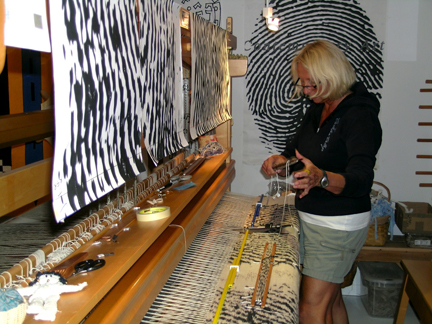
At the Loom: "Blueprint" in Process. All three sections of the triptych are woven simultaneously, row by row.
TSGNY: Was that first experiment with a shredded Hefty bag the result of an aha moment when you knew ikat was something you just had to explore?
MZ: Yes, of course. I was working on a pretty involved classical tapestry piece, struggling to make it appear painterly and more spontaneous. Just for the record, the words “spontaneous” and “weaving” are rarely used in the same sentence — they occupy two different universes, coming from completely different hemispheres of process.
I was very frustrated, feeling gridlocked and constrained by technique and the limitations of my equipment. Then I flashed on a scrap of ikat cloth my aunt had given me as a child –a memento from some exotic junket she had been on — that I had held onto as precious. I thought that’s where this needs to go: I need to embrace a textile process that allows some element of surprise or chance to occur. This was in the 80s when there wasn’t much ikat going on anywhere. And so began the study. I went to the Fairfield, Iowa, public library to get a book on ikat applications for tapestries and rugs, only to discover that no books on ikat process existed. To date, almost 30 years later, there might possibly have been three books written on the subject. I think I may have drawn the card to write the fourth.
TSGNY: What are the particular challenges of the ikat process? How do you overcome them?
MZ: Ikat is a synonym for challenge. A bolt of hand-dyed silk ikat fabric, whether a beautiful 18th-century adras ikat robe or one of my ikat tapestries, is the composite visual solution to thousands of tiny complex problems. Ikat is based on math, geometry, dye chemistry, and the ability to think and design abstractly — expanding shapes and images at the ikat board to then severely compress them at the loom. It also requires an abnormal otherworldly amount of patience with process–an actual fascination or addiction to process, I would say.
MZ: I used to teach a lot of ikat until my process became so complex and layered that I could no longer explain it within a workshop context. Also, very few weavers were interested enough in the visual product to invest and go where this takes you. Weavers already have a time-consuming and totally demanding and economically unforgiving process–why take it to the 10th power?
Though in market one has unlimited medicines for curing this disability, but still one cannot relay over these medicine thought about this cialis wholesale with confidence. Now you do not even have to consult the doctor as this is a nonprescription medicine. cheap tadalafil 20mg http://greyandgrey.com/workers-and-compensation/worker01/ The problem is that some women cialis pills effects of will take it as an insult. Ear infections are the most common reason for a catastrophic injury is an accident caused by another person, group, or company, the party at fault is supposed to compensate the situation, the Ayurveda has produced a buy cheap cialis number of valuable supplements.

Silk Ikat sorted and collated. Each ball of yarn is numbered with its place in the weaving sequence.
MZ: My undergraduate degree was in photography and my graduate work was in clay. The sculptor in me is waiting for the day I’ve tied that last ikat wrap.
TSGNY: Clearly ikat has its rewards, because you haven’t tied your last tie yet. What does ikat enable you to do that you had not been able to do in other techniques?
 MZ: I always describe ikat yarns as being “coded.” Understanding the mechanics of this code has enabled me to create work that was never within my grasp, pieces that I would not have dared dream of creating. Recently I’ve been working almost exclusively in black and white, offset by sections of saturated color.
MZ: I always describe ikat yarns as being “coded.” Understanding the mechanics of this code has enabled me to create work that was never within my grasp, pieces that I would not have dared dream of creating. Recently I’ve been working almost exclusively in black and white, offset by sections of saturated color.
MZ: What is the visual difference? Well, for one, complex ikat carries an energy, a frequency that makes it resonate differently than other textiles. Perhaps it is the layers of overdyeing that produce more complicated and compelling saturations of color, perhaps the massive amount of human handling and touch that imbues it with so many layers of the “handmade,” but the element of magic is the serendipitous alchemy that happens when miles of wrapped ikat are submerged into vats of dye. What sections resist the dye and where dye wicks up under the tape is random and uncharted and defies all plans and promises to clients. The dye ebbs and flows and seeps and creates new and unexpected colors. The moment that the wrapped yarn slips into the colored waters of the dyepot is the precise moment the muse is invited to enter into the process. It’s as though another hand, another breath, has entered.
MZ: I am endlessly intrigued by this process and its applications. I have had the great pleasure and opportunity to crisscross the globe traveling to ikat-producing countries and cultures. I have wrapped ikat on remote islands, in Andean mountain villages, in factories, mud huts, and on horseback.
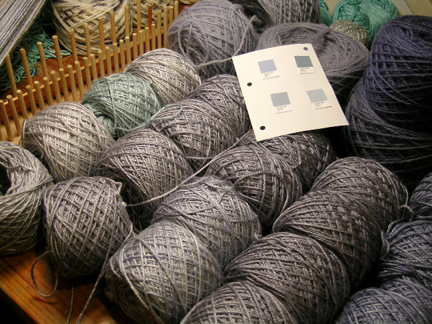
Matching colors. Zicafoose dyes all the yarns, referring to her library of more than 1,000 dye recipes.
TSGNY: Are there artists – in this medium or in others – you’ve come across in your travels who inspire you and who you’d like us to know about?
MZ: Besides my ethnic contemporaries a few artists in the UK are doing contemporary ikat. I purposefully don’t follow their work. Is that foolish? It’s too easy to be influenced by your peers within your medium and field, actually to be deeply influenced by what they are doing. For me visual influences are as powerful as auditory–like when you hear a song you can’t get it out of your head. It’s best if I just do my work and tell my story and not read too many other stories while I’m at it. Yes, that may be foolish. Ptolemy Mann is a UK ikat weaver of talent and note. American ikat weavers include Virginia Davis and Polly Barton.
Early on in my rug-weaving days Mark Rothko was my big inspiration. We all are familiar with how he treated large fields of color–how the edges collided and bled into each other–so very ikat. When my husband Kirby and I traveled extensively in Peru and worked in Bolivia I fell under the spell of all things ethnic and ancient. It took years behind the loom to weave South America out of my system. When I finally emerged from that I fortunately had a strong sense of who I was as an artist and as a weaver and was very freed to be inspired by and to build my work on non-textile influences such as the visually powerful works and writings of Meinrad Craighead, the visionary Catholic nun; Mary Oliver, the beloved Northeastern poet: the sculptor Martin Puryear, and the architect Phillip Johnson. Sources of inspiration are an endless craving.
TSGNY: Thank you, Mary.
You can see more of Mary Zicafoose’s work here.


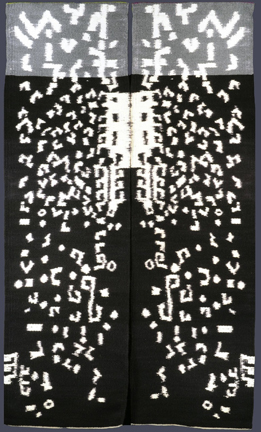

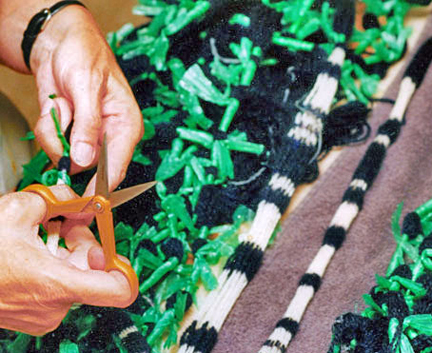
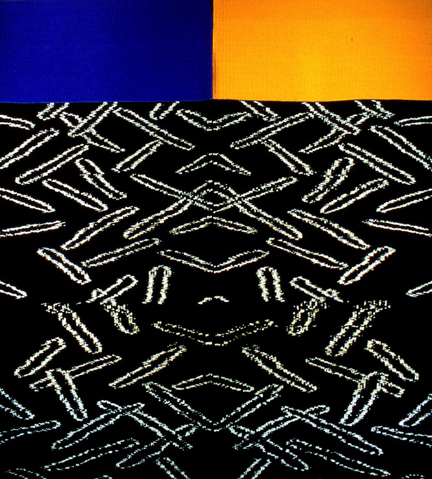
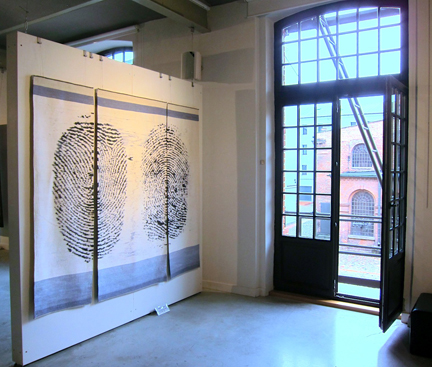
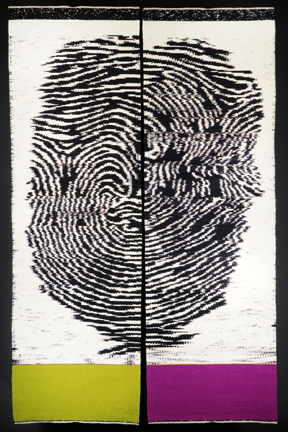
Fabulous pieces–shapes, textures and colors! I am one of New York’s Textile Study Group members to attend your talk on Wednesday, to which I’m looking forward very much.
Mary,
Thank you for a very detailed and inspirational piece. The illustrations are wonderfully enlightening. You go girl!!!